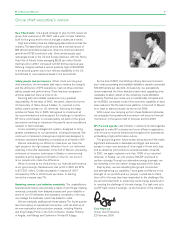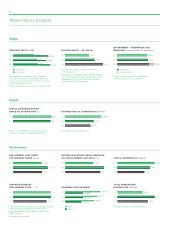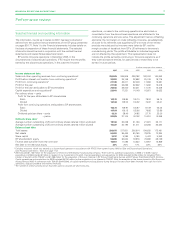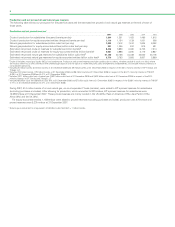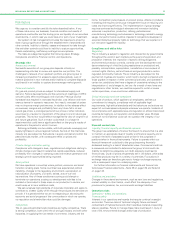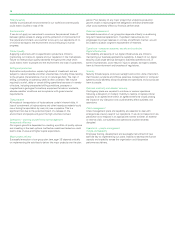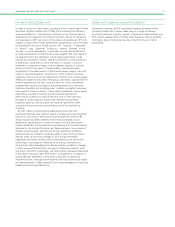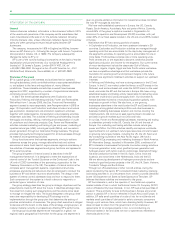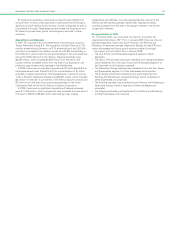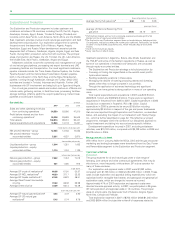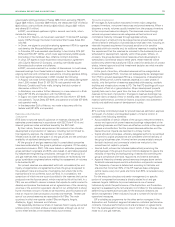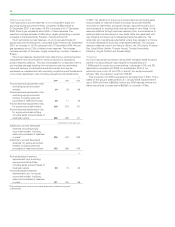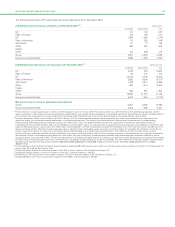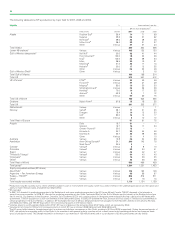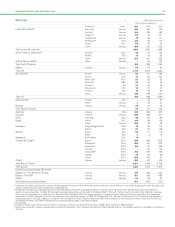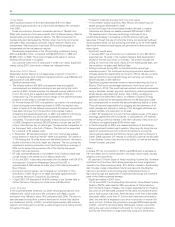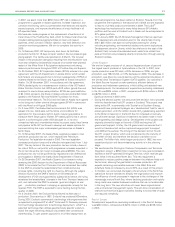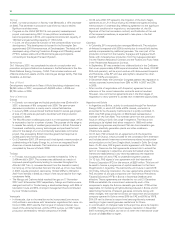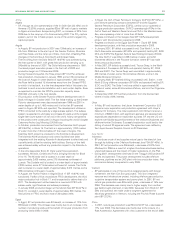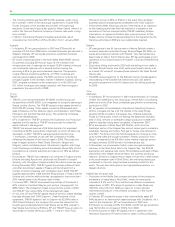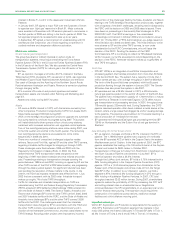BP 2007 Annual Report Download - page 17
Download and view the complete annual report
Please find page 17 of the 2007 BP annual report below. You can navigate through the pages in the report by either clicking on the pages listed below, or by using the keyword search tool below to find specific information within the annual report.
unsuccessful drilling activities in Russia ($86 million excluding TNK-BP),
Egypt ($49 million), Colombia ($49 million), the deepwater Gulf of Mexico
($36 million), onshore North America ($36 million), Angola ($27 million)
and others ($11 million).
In 2007, we obtained upstream rights in several new tracts, which
include the following:
– In the Gulf of Mexico, we have been awarded 171 blocks (BP average
equity 100%) through the Outer Continental Shelf Lease Sales 204
and 205.
– In Oman, we signed a production-sharing agreement (PSA) to appraise
and develop the Khazzan/Makarem gas fields.
– In Colombia, BP was awarded operatorship in two blocks, RC4 (BP
35%) and RC5 (BP 100%), which cover approximately 6,200 square
kilometres in the Caribbean Sea, offshore northern Colombia.
– In Libya, BP signed a major exploration and production agreement
with Libya’s National Oil Company, covering over 53,000 square
kilometres both onshore and offshore.
In 2007, we were involved in a number of discoveries. In most cases,
reserves bookings from these fields will depend on the results of
ongoing technical and commercial evaluations, including appraisal drilling.
Our most significant discoveries in 2007 included the following:
– In Angola, we made further discoveries in the ultra deepwater (greater
than 1,500 metres) Block 31 (BP 26.7% and operator) with the
Miranda, Cordelia and Portia wells, bringing the total number of
discoveries in Block 31 to 15.
– In Azerbaijan, we made a further discovery in a new reservoir in Shah
Deniz (BP 25.5% and operator) with the SDX-04 well.
– In Egypt, we made three discoveries with the Giza North-1 (BP 60%
and operator), Taurus Deep (BP 60% and operator) and Satis (BP 50%
and operator) wells.
– In the deepwater Gulf of Mexico, we made a discovery with the
Isabela well (BP 67% and operator).
Reserves and production
Compliance
IFRS does not provide specific guidance on reserves disclosures. BP
estimates proved reserves in accordance with SEC Rule 4-10 (a) and
relevant guidance notes and letters issued by the SEC staff.
By their nature, there is always some risk involved in the ultimate
development and production of reserves, including, but not limited to,
final regulatory approval, the installation of new or additional
infrastructure as well as changes in oil and gas prices and the continued
availability of additional development capital.
All the group’s oil and gas reserves held in consolidated companies
have been estimated by the group’s petroleum engineers. Of the equity-
accounted volumes in 2007, 16% were based on estimates prepared by
group petroleum engineers and 84% were based on estimates prepared
by independent engineering consultants, although all of the group’s oil
and gas reserves held in equity-accounted entities are reviewed by the
group’s petroleum engineers before making the assessment of volumes
to be booked by BP.
Our proved reserves are associated with both concessions (tax and
royalty arrangements) and agreements where the group is exposed to
the upstream risks and rewards of ownership, but where title to the
hydrocarbons is not conferred, such as PSAs. In a concession, the
consortium of which we are a part is entitled to the reserves that can be
produced over the licence period, which may be the life of the field. In a
PSA, we are entitled to recover volumes that equate to costs incurred to
develop and produce the reserves and an agreed share of the remaining
volumes or the economic equivalent. As part of our entitlement is driven
by the monetary amount of costs to be recovered, price fluctuations will
have an impact on both production volumes and reserves. Thirteen per
cent of our proved reserves are associated with PSAs. The main
countries in which we operate under PSAs are Algeria, Angola,
Azerbaijan, Egypt, Indonesia and Vietnam.
We separately disclose our share of reserves held in equity-accounted
entities (jointly controlled entities and associates), although we do not
control these entities or the assets held by such entities.
Resource progression
BP manages its hydrocarbon resources in three major categories:
prospect inventory, non-proved resources and proved reserves. When a
discovery is made, volumes usually transfer from the prospect inventory
to the non-proved resource category. The resources move through
various non-proved resource sub-categories as their technical and
commercial maturity increases through appraisal activity.
Resources in a field will only be categorized as proved reserves when
all the criteria for attribution of proved status have been met, including an
internally imposed requirement for project sanction or for sanction
expected within six months and, for additional reserves in existing fields,
the requirement that the reserves be included in the business plan and
scheduled for development, typically within three years. Where, on
occasion, the group decides to book reserves where development is
scheduled to commence beyond three years, these reserves will be
booked only where they satisfy the SEC’s criteria for attribution of proved
status. Internal approval and final investment decision are what we refer
to as project sanction.
At the point of sanction, all booked reserves will be categorized as
proved undeveloped (PUD). Volumes will subsequently be recategorized
from PUD to proved developed (PD) as a consequence of development
activity. When part of a well’s reserves depends on a later phase of
activity, only that portion of reserves associated with existing, available
facilities and infrastructure moves to PD. The first PD bookings will occur
at the point of first oil or gas production. Major development projects
typically take one to four years from the time of initial booking of PUD
reserves to the start of production. Changes to reserves bookings may
be made due to analysis of new or existing data concerning production,
reservoir performance, commercial factors, acquisition and divestment
activity and additional reservoir development activity.
Governance
BP’s centrally controlled process for proved reserves estimation approval
forms part of a holistic and integrated system of internal control. It
consists of the following elements:
– Accountabilities of certain officers of the group to ensure that there is
review and approval of proved reserves bookings independent of the
operating business and that there are effective controls in the approval
process and verification that the proved reserves estimates and the
related financial impacts are reported in a timely manner.
– Capital allocation processes, whereby delegated authority is exercised
to commit to capital projects that are consistent with the delivery of
the group’s business plan. A formal review process exists to ensure
that both technical and commercial criteria are met prior to the
commitment of capital to projects.
– Internal Audit, whose role includes systematically examining the
effectiveness of the group’s financial controls designed to assure the
reliability of reporting and safeguarding of assets and examining the
group’s compliance with laws, regulations and internal standards.
– Approval hierarchy whereby proved reserves changes above certain
threshold volumes require central authorization and periodic reviews.
The frequency of review is determined according to field size and
ensures that more than 80% of the BP reserves base undergoes
central review every two years and more than 90% is reviewed every
four years.
For the executive directors and senior management, no specific
portion of compensation bonuses is directly related to oil and gas
reserves targets. Additions to proved reserves is one of several
indicators by which the performance of the Exploration and Production
segment is assessed by the remuneration committee for the purposes of
determining compensation bonuses for the executive directors and
senior management. Other indicators include a number of financial and
operational measures.
BP’s variable pay programme for the other senior managers in the
Exploration and Production segment is based on individual performance
contracts. Individual performance contracts are based on agreed items
from the business performance plan, one of which, if they choose, could
relate to oil and gas reserves.
BP ANNUAL REPORT AND ACCOUNTS 2007 15


